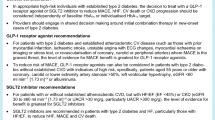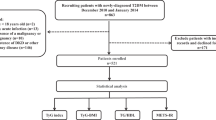Abstract
Background
The association of blood glucose [including fasting blood glucose (FBG), 2-h postload blood glucose, and glycated hemoglobin (HbA1c)] with the risk of a mild decline in the estimated glomerular filtration rate (eGFR) in healthy subjects was unclear. The aim of the study was to investigate this association in middle-aged and elderly healthy Chinese.
Methods
The study included 1,112 healthy Chinese who were ≥40 years old, and all the subjects were divided into two groups based on FBG value of 5.6 mmol/L. A mildly reduced eGFR was defined as 60–90 mL/min/1.73 m2. Multiple linear or logistic regression analysis was used to estimate the association of blood glucose with eGFR and the risk of a mildly reduced eGFR, respectively. A generalized additive model was used to explore a possible nonlinear relationship between FBG and eGFR.
Results
FBG was significantly associated with decreased eGFR and increased risk of a mildly reduced eGFR independent of age, gender, body mass index, waist circumference, systolic blood pressure (BP), diastolic BP, triglyceride, high-density lipoprotein cholesterol, fasting insulin, smoking, and drinking. Additionally, FBG and eGFR showed a nonlinear association (P < 0.001). Interestingly, the group with FBG ≥5.6 mmol/L significantly increased the risk of a mildly reduced eGFR (OR 2.06, P = 0.001) after multivariable adjustment.
Conclusions
FBG is closely associated with decreased eGFR and increased risk of a mildly reduced eGFR. The ADA criteria using FBG = 5.6 mmol/L instead of 6.1 mmol/L as cutoff point to define prediabetes are more suitable for the prevention of diabetes and related kidney disease.

Similar content being viewed by others
References
Tomonaga Y, Risch L, Szucs TD, Ambuehl PM (2013) The prevalence of chronic kidney disease in a primary care setting: a Swiss cross-sectional study. PLoS One 8:e67848
Zhang L, Wang F, Wang L et al (2012) Prevalence of chronic kidney disease in China: a cross-sectional survey. Lancet 379:815–822
Chen YC, Su YC, Lee CC, Huang YS, Hwang SJ (2012) Chronic kidney disease itself is a causal risk factor for stroke beyond traditional cardiovascular risk factors: a nationwide cohort study in Taiwan. PLoS One 7:e36332
Hallan SI, Matsushita K, Sang Y et al (2012) Age and association of kidney measures with mortality and end-stage renal disease. JAMA 308:2349–2360
Hermans MM, Henry R, Dekker JM et al (2007) Estimated glomerular filtration rate and urinary albumin excretion are independently associated with greater arterial stiffness: the Hoorn study. J Am Soc Nephrol 18:1942–1952
Henry RM, Kostense PJ, Bos G et al (2002) Mild renal insufficiency is associated with increased cardiovascular mortality: the Hoorn study. Kidney Int 62:1402–1407
Roy SK, Cespedes A, Li D, Choi TY, Budoff MJ (2011) Mild and moderate pre-dialysis chronic kidney disease is associated with increased coronary artery calcium. Vasc Health Risk Manag 7:719–724
Natali A, Boldrini B, Baldi S et al (2013) Impact of mild to moderate reductions of glomerular filtration rate on coronary artery disease severity. Nutr Metab Cardiovasc Dis 24:681–688
Campbell NG, Varagunam M, Sawhney V et al (2012) Mild chronic kidney disease is an independent predictor of long-term mortality after emergency angiography and primary percutaneous intervention in patients with ST-elevation myocardial infarction. Heart 98:42–47
Fox CS, Larson MG, Leip EP et al (2004) Predictors of new-onset kidney disease in a community-based population. JAMA 291:844–850
Xu Y, Wang L, He J et al (2013) Prevalence and control of diabetes in Chinese adults. JAMA 310:948–959
Pyram R, Kansara A, Banerji MA, Loney-Hutchinson L (2012) Chronic kidney disease and diabetes. Maturitas 71:94–103
Collins AJ, Foley RN, Herzog C et al (2011) US renal data system 2010 annual data report. Am J Kidney Dis 57(A8):e1–e526
Tomaszewski M, Charchar FJ, Maric C et al (2007) Glomerular hyperfiltration: a new marker of metabolic risk. Kidney Int 71:816–821
Koulouridis E, Georgalidis K, Kostimpa I et al (2010) Metabolic syndrome risk factors and estimated glomerular filtration rate among children and adolescents. Pediatr Nephrol 25:491–498
Melsom T, Mathisen UD, Ingebretsen OC et al (2011) Impaired fasting glucose is associated with renal hyperfiltration in the general population. Diabetes Care 34:1546–1551
Ning G; Reaction Study Group (2012) Risk evaluation of cancers in Chinese diabetic individuals: a longitudinal (REACTION) study. J Diabetes 4:172–173
Matthews DR, Hosker JP, Rudenski AS et al (1985) Homeostasis model assessment: insulin resistance and beta-cell function from fasting plasma glucose and insulin concentrations in man. Diabetologia 28:412–419
Levey AS, Stevens LA, Schmid CH et al (2009) A new equation to estimate glomerular filtration rate. Ann Intern Med 150:604–612
Expert Panel on Metabolic Syndrome of Chinese Diabetes Society (2004) Recommendations on metabolic syndrome of Chinese diabetes society. Chin J Diabetes 12:156–161
American Diabetes Association (2010) Diagnosis and classification of diabetes mellitus. Diabetes Care 33:S62–S69
Alberti KG, Zimmet PZ (1998) Definition, diagnosis and classification of diabetes mellitus and its complications. Part 1: diagnosis and classification of diabetes mellitus provisional report of a WHO consultation. Diabetes Med 15:539–553
Magee GM, Bilous RW, Cardwell CR et al (2009) Is hyperfiltration associated with the future risk of developing diabetic nephropathy? A meta-analysis. Diabetologia 52:691–697
Okada R, Wakai K, Naito M et al (2012) Renal hyperfiltration in prediabetes confirmed by fasting plasma glucose and hemoglobin A1c. Ren Fail 34:1084–1090
Okada R, Yasuda Y, Tsushita K et al (2012) Glomerular hyperfiltration in prediabetes and prehypertension. Nephrol Dial Transpl 27:1821–1825
Stevens LA, Levey AS (2009) Measured GFR as a confirmatory test for estimated GFR. J Am Soc Nephrol 20:2305–2313
Jessani S, Levey AS, Bux R et al (2014) Estimation of GFR in South Asians: a study from the general population in Pakistan. Am J Kidney Dis 63:49–58
Acknowledgments
This study was supported by Grants from the Chinese Society of Endocrinology, the National Natural Science Foundation of China (No. 81100617), the Medical and Health Science and Technology Development Projects of Shandong Province (2011HD005), the National Science and Technology Support Plan (2009BAI80B04), the Natural Science Foundation of Shandong Province (ZR2012HM014), the International Science and Technology Projects of Shandong Province (2012GGE27126), the Business Plan of Jinan Students Studying Abroad (20110407), and the special scientific research fund of clinical medicine of Chinese Medical Association (12030420342).
Conflict of interest
The authors declare that they have no conflict of interest.
Author information
Authors and Affiliations
Corresponding authors
Additional information
Yu Sun and Chuan Wang have contributed equally to this work.
Rights and permissions
About this article
Cite this article
Sun, Y., Wang, C., Yang, W. et al. Fasting blood glucose, but not 2-h postload blood glucose or HbA1c, is associated with mild decline in estimated glomerular filtration rate in healthy Chinese. Int Urol Nephrol 47, 147–152 (2015). https://doi.org/10.1007/s11255-014-0880-1
Received:
Accepted:
Published:
Issue Date:
DOI: https://doi.org/10.1007/s11255-014-0880-1




